Science Animal Kingdom Test 4 Lesson 10 Unit 2
SOL 4.7 The Solar System - Key concepts:
- the planets in the solar system;
- the order of the planets in the solar system
- the relative sizes of the planets
SOL 4.8 Sun, Moon, Earth- Key concepts:
- the motions of Earth, the moon, and the sun; the causes for Earth's seasons;
- the causes for the phases of the moon
- the relative size, position, age, and makeup of Earth, the moon, and the sun; and
- historical contributions in understanding the Earth-moon-sun system.
CLICK to learn more -- Click again to close
OUR SOLAR SYSTEM
- Our solar system is ancient. Early astronomers believed that Earth was the center of the universe and all other heavenly bodies orbited around Earth.
- We now know that our sun is the center of our solar system and eight planets, a handful of dwarf planets, 170 named moons, dust, gas, and thousands of asteroids and comets orbit around the sun.
THE EIGHT PLANETS
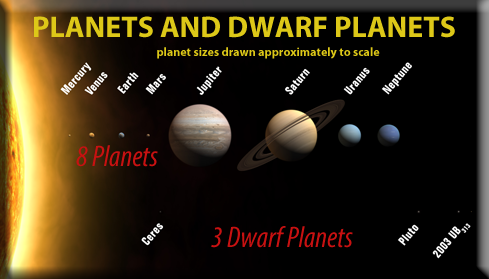
- Our solar system is made up o f eight planets: Mercury, Venus, Earth, Mars, Jupiter, Saturn, Uranus, and Neptune.
- The eight planets sorted by size from largest to smallest are: Jupiter, Saturn, Uranus, Neptune, Earth, Venus, Mars, and Mercury.
INNER TERRESTRIAL PLANETS
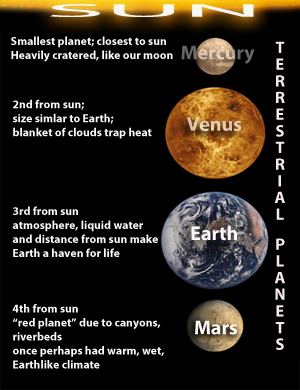
- Mercury, Venus, Earth, and Mars are considered terrestrial planets.
- Mercury is closest to the sun and is a small, heavily cratered planet. Mercury looks like our moon. Since Pluto's reclassification from planet to dwarf planet, Mercury is now the smallest planet in our solar system.
- Venus is second from the sun. It is similar to Earth in size and mass, and has a permanent blanket of clouds that trap so much heat that the temperatures on the surface of Venus are hot enough to melt lead.
- Earth is third from the sun. Earth's atmosphere, the liquid water found on Earth, and its distance from the sun, among many other factors, make Earth a haven for life.
- Mars is fourth from the sun. The atmosphere on Mars is thin and there is a vast network of canyons and riverbeds on the red planet. Scientists hypothesize that Mars once supported a wet, warm Earth-like climate.
GAS GIANTS
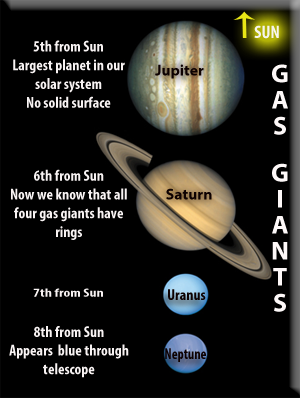
- Jupiter, Saturn, Uranus, and Neptune are called gas giants.
- Jupiter is fifth from the sun. Jupiter is the largest planet in the solar system and is considered a gas giant. Jupiter has no solid surface.
- Saturn is sixth from the sun. Early scientists thought Saturn was the only planet with rings, but we now know that all four gas giants (Jupiter, Saturn, Uranus, and Neptune) have rings
- Uranus is seventh from the sun. Uranus is a gas giant.
- Neptune is eighth from the sun. Neptune appears blue through telescopes and is a gas giant.
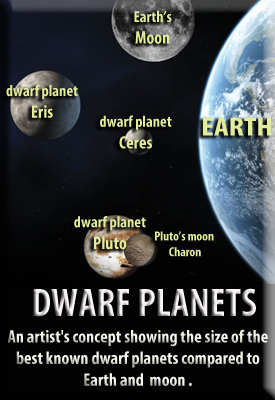
DWARF PLANETS
- Pluto is no longer included in the list of planets in our solar system due to its small size and irregular orbit.
- Many astronomers questioned whether Pluto should be grouped with worlds like Earth and Jupiter.
- In 2006, this debate led the International Astronomical Union (IAU), the recognized authority in naming heavenly objects, to formally reclassify Pluto.
- On August 24, 2006, Pluto's status was officially changed from planet to dwarf planet.
- A new distinct class of objects called "dwarf planets" was identified in 2006. It was agreed that "planets" and "dwarf planets" are two distinct classes of objects.
- The first members of the dwarf planet category are Ceres, Pluto and 2003 UB313, given the name Eris. More dwarf planets are expected to be announced by the IAU in the future.
- What differentiates a dwarf planet from a planet?
- For the most part, they are identical, but there is one key difference: A dwarf planet has not "cleared the neighborhood" around its orbit, which means it has not become gravitationally dominant and it shares its orbital space with other bodies of a similar size.
- Pluto is smaller than seven of the moons in our solar system and cannot be seen without a telescope.
ROTATION, REVOLUTION, TILT
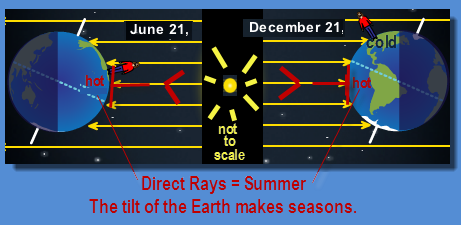
- Earth completes one revolution around the sun every 365 ¼ days.
- The moon revolves around Earth about once every month.
- Due to its axial tilt, Earth experiences seasons during its revolution around the sun.
- The phases of the moon are caused by its position relative to Earth and the sun. The phases of the moon include the new, waxing crescent, first quarter, waxing gibbous, full, waning gibbous, last (third) quarter, and waning crescent.
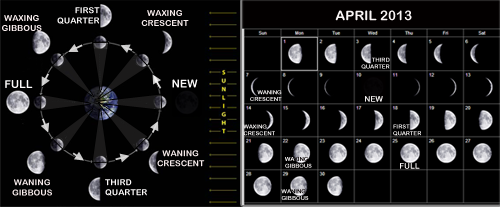
SUN, MOON, EARTH -- SIZE & MAKEUP
- The sun is an average-sized yellow star, about 110 times the diameter of Earth. The sun is approximately 4.6 billion years old.
- Our moon is a small rocky satellite, having about one-quarter the diameter of Earth and one-eightieth its mass. It has extremes of temperature, virtually no atmosphere or life, and very little water.
- Earth is one of eight planets that revolve around the sun and comprise the solar system. Earth, the third planet from the sun, is one of the four terrestrial inner planets. It is about 150 million kilometers from the sun.
- Earth is a geologically active planet with a surface that is constantly changing. Unlike the other three inner planets (Mercury, Venus, and Mars), it has large amounts of life-supporting water and an oxygen-rich atmosphere. Earth's protective atmosphere blocks out most of the sun's damaging rays.
HISTORICAL CONTRIBUTIONS
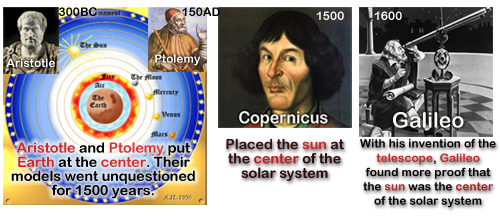
- Our understanding of the solar system has changed from an Earth-centered model of Aristotle and Ptolemy to the sun-centered model of Copernicus and Galileo.
- The NASA Apollo missions added greatly to our understanding of the moon.
- Our understanding of the sun, moon, and the solar system continues to change with new scientific discoveries.
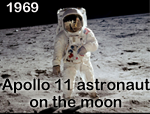
Science Animal Kingdom Test 4 Lesson 10 Unit 2
Source: https://www.solpass.org/sci4.html

0 Response to "Science Animal Kingdom Test 4 Lesson 10 Unit 2"
Post a Comment